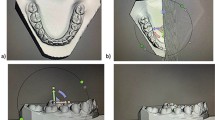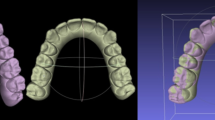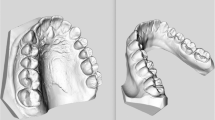Abstract
Purpose
The aim of this study was to examine possible parameters correlating to the shape of the curve of Spee (COS) by analyzing multiple setups of the same Angle class I patient case.
Methods
In all, 65 setups of the same Angle class I patient case were constructed. We measured the depth of the COS, length and width of the dental arch, steps, rotations, spaces and symmetry of the constructed setups. With a correlation analysis, possible relationships between the depth of the COS and measured parameters were evaluated.
Results
The COS in the constructed setups was more exaggerated than in the reference case but none of the measured parameters correlated to the depth of the COS. The largest deviation was found on the mesiobuccal cusp tip of the first molar (−0.5 ± 0.4 mm left side; −0.8 ± 0.5 mm right side). This study found a negative correlation between the length and width of the lower dental arch (r = −0.61). While maintaining Angle class I, a large spread width of the depth of the COS, the dental arch width and length was shown.
Conclusion
The different manifestations of the COS in this study show the freedom of arrangement of the individual tooth morphology without exhibiting a correlation to parameters of the dental arch.
Zusammenfassung
Ziel
Anhand der Analyse multipler Setups desselben Angle-Klasse-I-Patientenfalls sollte die Korrelation verschiedener Parameter mit der Spee-Kurve beurteilt werden.
Methoden
Es wurden 65 Setups eines Angle-Klasse-I-Patientenfalls erstellt und die Tiefe der Spee-Kurve, Stufen, Rotationen, Lücken und die Länge, Breite sowie die Symmetrie des Zahnbogens gemessen. Mittels einer Korrelationsanalyse wurden mögliche Beziehungen zwischen den gemessenen Parametern und der Tiefe der Spee-Kurve evaluiert.
Ergebnisse
Im Durchschnitt war die Spee-Kurve der konstruierten Setups ausgeprägter als im Referenzfall. Die größten Abweichungen wurden im Bereich des mesiobukkalen Höckers des ersten Molaren gemessen (−0,5 ± 0,4 mm links; −0,8 ± 0,5 mm rechts). Keiner der evaluierten Parameter korrelierte mit der Tiefe der Spee-Kurve. Es wurde eine negative Korrelation zwischen der Zahnbogenlänge und -breite des Unterkiefers (r = −0,61) gefunden. Diese Studie zeigt eine große Streubreite der Zahnbogenlängen und -breiten sowie der Tiefe der Spee-Kurve bei Einhaltung einer Angle-Klasse-I-Verzahnung.
Schlussfolgerung
Die verschiedenen Ausprägungen der Spee-Kurve in dieser Studie ohne Korrelation zu Zahnbogenparametern zeigen den Anordnungsspielraum der individuellen okklusalen Morphologie auf.






Similar content being viewed by others
References
Afzal A, Ahmed I (2006) Leveling curve of Spee and its effect on mandibular arch length. J Coll Physicians Surg Pak 16:709–711
Akkaya S, Lorenzon S, Üçm T (1998) Comparison of dental arch and arch perimeter changes between bonded rapid and slow maxillary expansion procedures. Eur J Orthod 20:255–261
AlQabandi AK, Sadowsky C, BeGole EA (1999) A comparison of the effects of rectangular and round arch wires in leveling the curve of Spee. Am J Orthod Dentofacial Orthop 116:522–529
Andrews LF (1972) The six keys to normal occlusion. Am J Orthod 62:296–309. https://doi.org/10.1016/S0002-9416(72)90268-0
Baldridge DW (1969) Leveling the curve of Spee: its effect on mandibular arch length. JPO J Pract Orthod 3:26–41
Baragar FA, Osborn JW (1987) Efficiency as a predictor of human jaw design in the sagittal plane. J Biomech 20:447–457. https://doi.org/10.1016/0021-9290(87)90246-6
Baydas B, Yavuz I, Atasaral N, Ceylan I, Dagsuyu IM (2004) Investigation of the changes in the positions of upper and lower incisors, overjet, overbite, and irregularity index in subjects with different depths of curve of Spee. Angle Orthod 74:349–355
Bernstein RL, Preston CB, Lampasso J (2007) Leveling the curve of Spee with a continuous archwire technique: A long term cephalometric study. Am J Orthod Dentofacial Orthop 131:363–371. https://doi.org/10.1016/j.ajodo.2005.05.056
Braun S, Hnat WP, Fender DE, Legan HL (1998) The form of the human dental arch. Angle Orthod 68:29–36
Carcara S, Preston CB, Jureyda O (2001) The relationship between the curve of spee, relapse, and the Alexander discipline. Semin Orthod 7:90–99. https://doi.org/10.1053/sodo.2001.23550
Cheon S‑H, Park Y‑H, Paik K‑S, Ahn S‑J, Hayashi K, Yi W‑J, Lee S‑P (2008) Relationship between the curve of Spee and dentofacial morphology evaluated with a 3-dimensional reconstruction method in Korean adults. Am J Orthod Dentofacial Orthop 133:640.e7–640.e14. https://doi.org/10.1016/j.ajodo.2007.11.020
Farella M, Michelotti A, Van Eijden TMGJ, Martina R (2002) The curve of Spee and craniofacial morphology: a multiple regression analysis. Eur J Oral Sci 110:277–281
Germane N, Staggers JA, Rubenstein L, Revere JT (1992) Arch length considerations due to the curve of Spee: A mathematical model. Am J Orthod Dentofacial Orthop 102:251–255. https://doi.org/10.1016/S0889-5406(05)81060-1
Halimi A, Benyahia H, Azeroual M‑F, Bahije L, Zaoui F (2018) Relationship between the curve of Spee and craniofacial variables: a regression analysis. Int Orthod 16:361–373
Howe RP, McNamara JA Jr, O’connor KA (1983) An examination of dental crowding and its relationship to tooth size and arch dimension. Am J Orthod 83:363–373
Kubein-Meesenburg D, Bormann V (1982) Ist der offene Biß bereits durch die okklusale Morphologie determiniert? J Orofac Orthop 43:359–368
Kubein-Meesenburg D, Jäger A, Hoffmann G (1986) Die sagittale Kompensationskurve und ihre Variation im Laufe des Lebens als Ausdruck der wachstumsbedingten Form- und Strukturveränderungen des Unterkiefers. J Orofac Orthop 47:48–66. https://doi.org/10.1007/bf02167596
Kubein-Meesenburg D, Naegerl H, Meyer G, Buecking W (1988) Individual reconstruction of palatal concavities. J Prosthet Dent 60:662–672. https://doi.org/10.1016/0022-3913(88)90394-0
Marshall SD, Caspersen M, Hardinger RR, Franciscus RG, Aquilino SA, Southard TE (2008) Development of the curve of Spee. Am J Orthod Dentofacial Orthop 134:344–352
Maurice T, Kula K (1998) Dental arch asymmetry in the mixed dentition. Angle Orthod 68:37–44
Osborn JW (1987) Relationship between the mandibular condyle and the occlusal plane during hominid evolution: some of its effects on jaw mechanics. Am J Phys Anthropol 73:193–207. https://doi.org/10.1002/ajpa.1330730206
Pandis N, Polychronopoulou A, Sifakakis I, Makou M, Eliades T (2010) Effects of levelling of the curve of Spee on the proclination of mandibular incisors and expansion of dental arches: a prospective clinical trial. Aust Orthod J 26:61
Preston CB, Maggard MB, Lampasso J, Chalabi O (2008) Long-term effectiveness of the continuous and the sectional archwire techniques in leveling the curve of Spee. Am J Orthod Dentofacial Orthop 133:550–555
Salem OH, Al-Sehaibany F, Preston CB (2003) Aspects of mandibular morphology, with specific reference to the antegonial notch and the curve of Spee. J Clin Pediatr Dent 27:261–265
Shannon KR, Nanda RS (2004) Changes in the curve of Spee with treatment and at 2 years posttreatment. Am J Orthod Dentofacial Orthop 125:589–596. https://doi.org/10.1016/j.ajodo.2003.09.027
Spee FG (1890) Die Verschiebungsbahn des Unterkiefers am Schädel. In: Archive für Anatomie und Entwicklungsgeschichte (Leipzig), pp 285–294
Author information
Authors and Affiliations
Corresponding author
Ethics declarations
Conflict of interest
T. Hampe, S. Krohn, F. Schmitt and D. Kubein-Meesenburg declare that they have no competing interests.
Rights and permissions
About this article
Cite this article
Hampe, T., Krohn, S., Schmitt, F. et al. The variability of the curve of Spee. J Orofac Orthop 81, 89–99 (2020). https://doi.org/10.1007/s00056-019-00213-6
Received:
Accepted:
Published:
Issue Date:
DOI: https://doi.org/10.1007/s00056-019-00213-6




